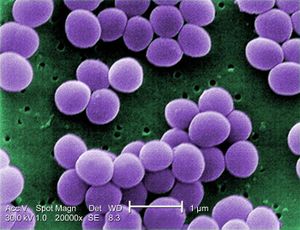Quorum Sensing in Staphylococcus aureus Infections: Difference between revisions
| Line 1: | Line 1: | ||
{{Curated}} | {{Curated}} | ||
==Introduction to <i>Staphylococcus aureus</i>== | ==Introduction to <i>Staphylococcus aureus</i>== | ||
[[Image:staphsem.jpg|thumb|300px|right|Scanning electron micrograph of Staphylococcus aureus | [[Image:staphsem.jpg|thumb|300px|right|Scanning electron micrograph (SEM) of <i>Staphylococcus aureus</i> bacteria from a vancomycin intermediate resistant culture (VISA). Micrograph taken by Janice Hardy Carr at the Center for Disease control in 2001 [http://phil.cdc.gov/phil/details.asp?pid=11157 CDC].]] | ||
<br>By Elizabeth Eder<br> | <br>By Elizabeth Eder<br> | ||
<br> | <br> | ||
Revision as of 06:55, 16 November 2015
Introduction to Staphylococcus aureus

By Elizabeth Eder
Staphylococcus aureus is a gram-positive cocci-shaped bacterium that commonly colonizes human epithelia. Epithelial surfaces include the skin and respiratory tract, and in these areas S. aureus is considered a natural component of the human microbiome and does not serve as a benefit or detriment to its human host. First identified in 1880, S. aureus is a facultative anaerobe, meaning it generates ATP with or without oxygen. While S. aureus is not naturally pathogenic on epithelial surfaces, infections can occur in these areas and range from pimples and impetigo to pneumonia and meningitis. Pathogenicity can develop through the infection of S. aureus in the bloodstream, and these infections are of great medical relevance due to their prevalence and virulence. Infections can be community-acquired (CA) or hospital-acquired (HA), with the latter illustrating the challenge of sterility in healthcare settings.
Compounding the issue of infection is the bacteria’s ability to develop drug resistance, resulting in strains such as methicillin-resistant staphylococcus aureus (MRSA). These strains have been of increasing concern in the medical field for their persistence in nosocomial infections and comprise the majority of S. aureus infections (Boucher). The frequency of S. aureus infections, and the frequency of those infections acquiring methicillin-resistance, is increasing in hospitals in the U.S. The CDC reported a 62% increase in S. aureus-related hospitalizations from 1999 to 2005, and suggested that MRSA be considered “a national priority for disease control.” Understanding the molecular mechanism of virulence is critical for addressing the issue of S. aureus and MRSA infections, because the resistance that S. aureus develops seriously limits antibiotic usefulness. Despite the advances in patient care, technology, and heath environment sterility, S. aureus infections continue to be an issue in U.S. hospitals and communities. One mechanism of S. aureus that is currently being studied for its potential contribution to pathogenicity is the quorum sensing (QS) system of communication.
Medical Relevance and MRSA
Include some current research, with at least one figure showing data.
Quorum Sensing System
Include some current research, with at least one figure showing data.
QS and Pathogenicity
Include some current research, with at least one figure showing data.
Infection Prevention and Treatment
References
[1] Boucher, HW and Corey, GR (2008) Epidemiology of methicillin-resistant Staphylococcus aureus. Clinical Infectious Diseases 46:344-349.
[2] Haddadin, AS, Fappiano, SA, Lipsett, PA (2002) Methicillin resistant Staphylococcus aureus (MRSA) in the intensive care unit. Postgrad Med J 78:385-392.
[3] Novick, RP and Geisinger, E (2008) Quorum sensing in Staphylococci. Annu Rev Genet 42:541-564.
[4] Yarwood, JM, Bartels, DJ, Volper, EM, Greenberg, EP (2004) Quorum sensing in Staphylococcus aureus biofilms. J Bacteriol 186:1838-1850.
[5] Periasamy, S, Joo, H, Duong, AC, Bach, TL, Tan, VY, Chatterjee, SS, Cheung, GY, Otto, M (2011) How Staphylococcus aureus biofilms develop their characteristic structure. PNAS 109:1281-1286.
[6] Rutherford, ST and Bassler, BL (2012) Bacterial quorum sensing: its role in virulence and possibilities for its control. Cold Spring Harb Perspect Med 2:a012427.
[7] Yarwood, JM, Schlievert, PM (2003) Quorum sensing in Staphylococcus infections. J. Clin. Invest. 112:1620-1625.
[8] Klein, E, Smith, DL, Laxminarayan, R (2007) Hospitalizations and deaths caused by methicillin-resistant Staphylococcus aureus, United States, 1999–2005. Emerg Infect Dis 13(12):1840-1846.
Authored for BIOL 291.00 Health Service and Biomedical Analysis, taught by Joan Slonczewski, 2016, Kenyon College.
